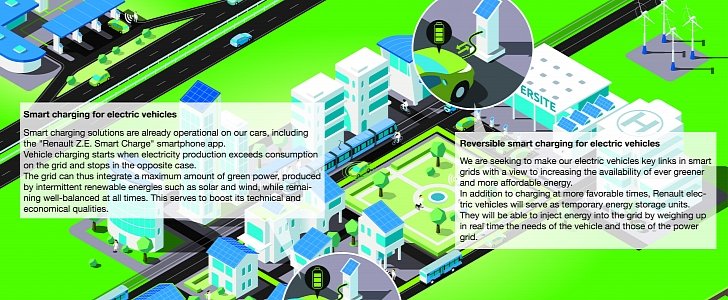Having sold enough electric vehicles to really consider adding more models to the offering, French manufacturer Renault is currently hard at work trying fo find better and smarter solution for charging EVs, the single most serious obstacle in the path of widespread adoption of electric transportation.
Such a smart solution would be vehicle-to-grid (V2G) charging, a system through which electric vehicles would either pull or return electricity to the grid.
Usually, EVs only draw power from the grid, as they need it to charge their batteries, but when these cars are parked, they can also be used by the grid as a means to store electricity for when needed.
Together with Empresa de Electricitade da Madeira, the local energy provider in Madeira and Porto Santo, the two islands of the Madeira archipelago, Renault will try to test V2G together with a wider system that could make electric vehicles more appealing.
The two companies aim to create a “smart electric ecosystem” based on electric vehicles, stationary energy storage, smart charging and V2G charging. For the tests, 14 Zoe and six Kangoo Z.E. electric vehicles will be handed to 20 volunteer users in Porto Santo to use daily.
The first part of the test will comprise charging via the existing 40 connected public and private charging points on Porto Santo. By the end of 2018, vehicles will step up their interaction with the grid by providing it with electricity during peak hours.
The third stage of the tests will see the use of second-life batteries from Renault electric vehicles as storage for power coming from solar and wind farms on the islands. That means that instead of throwing the used batteries from vehicles away, Renault will try and integrate them back in the system as stationary energy storage.
For EV owners, V2G charging may prove a cheaper, better way of owning an EV. Charging a car through this system would allow them to save money by using the electricity when supply exceeds demand, but also from acting as backups for the grid during peak hours.
Usually, EVs only draw power from the grid, as they need it to charge their batteries, but when these cars are parked, they can also be used by the grid as a means to store electricity for when needed.
Together with Empresa de Electricitade da Madeira, the local energy provider in Madeira and Porto Santo, the two islands of the Madeira archipelago, Renault will try to test V2G together with a wider system that could make electric vehicles more appealing.
The two companies aim to create a “smart electric ecosystem” based on electric vehicles, stationary energy storage, smart charging and V2G charging. For the tests, 14 Zoe and six Kangoo Z.E. electric vehicles will be handed to 20 volunteer users in Porto Santo to use daily.
The first part of the test will comprise charging via the existing 40 connected public and private charging points on Porto Santo. By the end of 2018, vehicles will step up their interaction with the grid by providing it with electricity during peak hours.
The third stage of the tests will see the use of second-life batteries from Renault electric vehicles as storage for power coming from solar and wind farms on the islands. That means that instead of throwing the used batteries from vehicles away, Renault will try and integrate them back in the system as stationary energy storage.
For EV owners, V2G charging may prove a cheaper, better way of owning an EV. Charging a car through this system would allow them to save money by using the electricity when supply exceeds demand, but also from acting as backups for the grid during peak hours.

